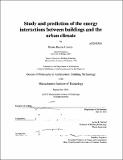Study and prediction of the energy interactions between buildings and the urban climate
Author(s)
Bueno Unzeta, Bruno
DownloadFull printable version (19.01Mb)
Other Contributors
Massachusetts Institute of Technology. Dept. of Architecture.
Advisor
Leslie K. Norford.
Terms of use
Metadata
Show full item recordAbstract
Urbanization produces higher air temperatures in cities than in the undeveloped rural surroundings. This phenomenon is known as the Urban Heat Island (UHI) effect and has been measured in different cities around the world. Conventional building energy programs use standard meteorological databases obtained from measurements at operational weather stations, which are usually located in open areas outside of the city, typically at the airport. Therefore, air temperature measurements may not include the UHI effect. The UHI effect can have an impact on the energy consumption of buildings, especially residential and naturally ventilated buildings. At the same time, the energy performance of buildings can affect outdoor air temperatures, mainly through the waste heat emissions from outdoor air-conditioning equipment. Consequently, there are situations in which the interactions between the indoor and outdoor environments are reciprocal and thus both domains have to be solved simultaneously. This thesis presents a study of the energy interactions between buildings and the urban climate through the development and evaluation of a set of models. Based on first principles, these models include three different Urban Canopy and Building Energy Models (UC-BEMs), with different levels of detail and applications, and a novel urban climate prediction tool, the Urban Weather Generator (UWG). Developed at the intersection of building energy and urban climate studies, the research builds on fundamental knowledge in both domains. The UC-BEMs account for building thermal effects on climatological predictions and have the potential to predict building energy consumption at urban scale. The UC-BEMs can be coupled with mesoscale atmospheric simulations, establishing a multi-scale model approach from the atmosphere down to buildings that can be used to analyze the impact of future climate change scenarios on the urban climate and the energy consumption of buildings. The UWG calculates site-specific urban climate conditions from measurements at an operational weather station. The model can be used alone or integrated into existing programs in order to account for the UHI effect in building energy simulations. The UWG is evaluated with field data from Toulouse, France, and Basel, Switzerland.
Description
Thesis (Ph. D. in Building Technology)--Massachusetts Institute of Technology, Dept. of Architecture, 2012. Cataloged from PDF version of thesis. Includes bibliographical references (p. 125-130).
Date issued
2012Department
Massachusetts Institute of Technology. Department of ArchitecturePublisher
Massachusetts Institute of Technology
Keywords
Architecture.